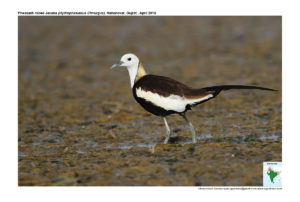Pheasant-tailed Jacana |

Pheasant-tailed Jacana Metopidius indicus
Etymology:
- Metopidius : Greek word for on the forehead derived from metopon – forehead, brow
- Indicus : From India
Vernacular names: Hindi: Jal pipi, Sans: Jalkapot, Bi: Pipi, Kundai, Kattoi, Ben: Dal pipi, Jal pipi, Karatiya, Ass: Dol punga, Cachar: Pipi, Mani: Thamnachenbi, Guj: Kalo jal manjar, Mar: Neelkamal, Soneri pankhacha/ Kansya Pankhi kamalpakshi, Ta: Thamara kozhi, Te: Kanchurekkalu jacana, Kan: Kenchu rekkeya neeru gili
Distribution in India: Widespread resident except in Himalayas.
Description: Size: 28-31cm. It is the only jacana with different breeding and non-breeding plumages. It has conspicuous white wings, with black outermost primaries and black tips to other primaries, outermost secondaries and greater primary-coverts; sharp, pointed carpal spur. In breeding plumage the head and lower neck is white, black patch present at rear of crown continues as black line down each side of neck separating glossy golden-yellow hindneck from white foreneck. The body and tail feathers vary from blackish brown to paler brown, with greenish wash on back; tips of outer primaries possess spatulate extension; tail graduated with central two feathers greatly elongated, 19–38 cm. The non-breeding plumage has upperparts paler greenish brown extending onto outer parts of lesser and median coverts; crown and hindneck blackish, golden-yellow on sides, with blackish-brown eyestripe continuing down sides of neck and forming breast band; tail graduated but much shorter, 11–12 cm. Female similar to male, but significantly larger. It has bare parts: iris brown to pale yellow, bill brown to yellowish base becoming slate-blue with yellow tip when breeding and legs and feet pale blue-grey.
Habitat: It is found in floating and emergent vegetation like lotus, lily, water hyacinth ,etc. Found in freshwater lakes, swamps, tanks, ponds, etc., especially in plains and in plateau country; also occurs in denser vegetation, wet grasslands, and overgrown paddy fields.
Food Habits: It eats insects and other invertebrates picked from the floating vegetation or the water’s surface. Also eats shoots and bulbs of water plants
Breeding Habits: They breed in July-Sept in India. They are polyandrous, with female defending three males or more, and laying 10 clutches per year. During breeding the male remains mounted on female for up to five minutes before brief, 1–2 second, cloacal contact. The nest is a pad of stems and pieces of aquatic vegetation. The nest construction is primarily by male. Some nests substantial, others disintegrate rapidly in rising water and sometimes eggs are simply laid on floating leaf; the male often moves clutch to new location. They lay a clutch of four eggs; replacement clutches laid every 6–15 days. The male alone incubates and provides all direct parental care, but female aids in territory defense. The chicks remain with male for up to 50–60 days; young capable of submerging almost completely in response to perceived danger.
.